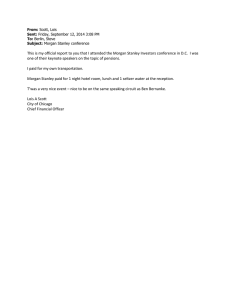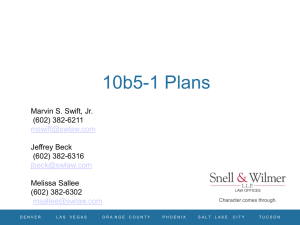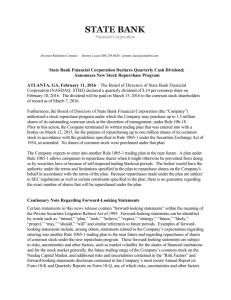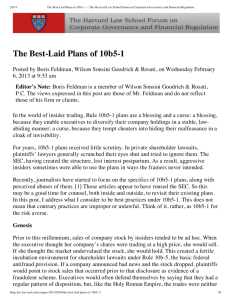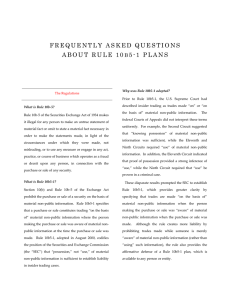Rule 10b5-1 Panel
advertisement
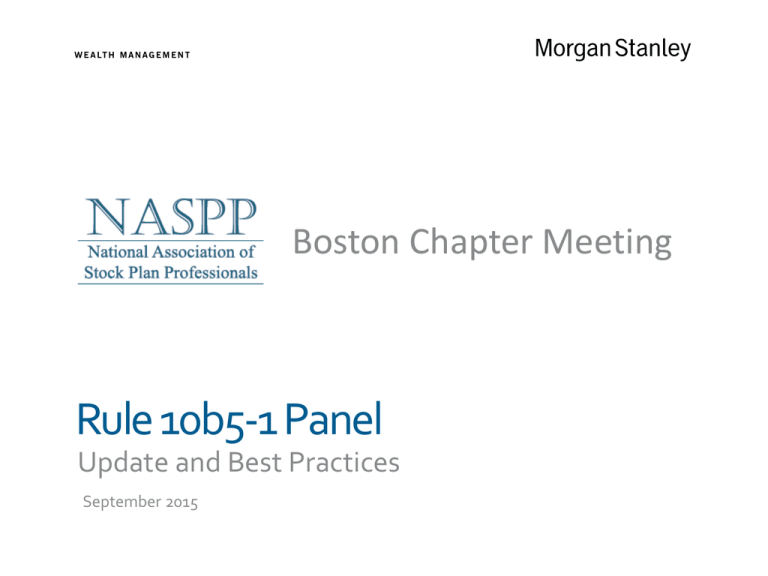
Boston Chapter Meeting Rule 10b5-1 Panel Update and Best Practices September 2015 Panelists Thomas S. Brennan Posternak, Blankstein & Lund LLP James Fucigna Executive Director Morgan Stanley Wealth Management Rich Baker, CEP Vice President Morgan Stanley Executive Financial Services Mr. Brennan is a partner at Posternak Blankstein & Lund LLP, a 60 attorney firm specializing in business law for early stage and middle market companies. Mr. Brennan specializes in public company compliance issues, including corporate disclosure, corporate governance, insider trading and reporting, annual meeting and proxy-related issues, stock exchange listing requirements, and executive compensation. Mr. Brennan also has extensive experience in mergers and acquisitions and intellectual property licensing. Mr. Brennan is a graduate of The Johns Hopkins University, Fordham University and the University of Maryland School of Law. James Fucigna is an Executive Director within Morgan Stanley’s Corporate Equity Solutions group. He leads a team of fourteen professionals that are dedicated to providing wealth management and equity compensation services to public companies, their employees and executives. James serves as the lead strategist on all wealth management relationships and focuses on helping the executives of client companies integrate their equity compensation into a customized, holistic wealth management plan. James received a Bachelor of Arts degree in Economics with distinction from the University of Connecticut. As Corporate Relationship Manager for the Executive Financial Services group, Rich manages the industry-leading(1) Rule 10b5-1 Trading Plan business for Private Wealth Management, focusing on some of the firm’s most sensitive relationships with directors, officers and issuers. Rich joined the firm in 2008 after completing his MBA at the Lubin School of Business at Pace University where he graduated with the Finance Department Award and was named the Birnbaum Scholar. (1) Based on data is compiled by the Washington Service from Form 144 filings in the period from 2/1/2005 to 12/31/2014. The Washington Service tracks insider trade information filed with the Securities & Exchange Commission. Information contained herein was obtained from sources believed reliable but the accuracy and completeness thereof cannot be guaranteed. Information contained herein is subject to change. 2 Table of Contents Section 1 Overview of Rule 10b5-1 and 10b5-1 Trading Plans Section 2 10b5-1 Market Data Section 3 Key Issues to Consider Section 4 Q&A Please note that any opinions expressed by the speakers are solely their own and does not necessarily reflect those of Morgan Stanley Wealth Management or its affiliates (“Morgan Stanley”). Morgan Stanley does not render legal or tax advice. 3 Overview of Rule 10b5-1 and 10b5-1 Trading Plans 4 SEC Rule 10b5-1 Background • Adopted in 2000. • Result of an acknowledgement by the SEC that senior executives and other insiders are often in possession of material non-public information (“MNPI”), and accordingly, it is difficult to trade their company stock without raising insider trading issues. • Rule 10b5-1 provides an affirmative defense from insider trading liability, even when the insider is aware of MNPI on the date of the trade, if certain requirements are met. • Typically, this is done through the use of a 10b5-1 Trading Plan (“10b5-1 Plan”) between the insider and his or her broker. 5 What is an Affirmative Defense? Affirmative Defense Safe Harbor Litigation tool, not an insurance policy Prove the safe harbor requirements and you are proven not guilty • Allows a defendant to raise a defense • Does not guarantee that he or she will win on that defense Example – Rule 144: • If you follow the rule, you will not even be charged with selling unregistered securities – the Rule defines an exemption, and that’s the end of the inquiry Under Rule 10b5-1 Even if you prove you have a trading plan, you could still: • Be sued for insider trading • Have to litigate an insider trading case • Be found liable for insider trading 6 How and when a plan is adopted and executed is key Key Requirements of a 10b5-1 Plan • No possession of MNPI at time of adoption of the 10b5-1 Plan. • Must be entered into in good faith and not in a scheme to defraud. • Insider can not exert any subsequent influence over execution of the 10b5-1 Plan. • The 10b5-1 Plan must: – Specify amounts, prices and dates, or – Provide a selling formula, or – Grant discretion to the broker (not common). • Should be part of issuer’s Insider Trading Policy. 7 Key Benefits of a 10b5-1 Plan Benefits to Insider: • Affirmative Defense: Offers protection against potential claims of insider trading. • Access to Public Markets: May allow order/trade executions without regard to corporate blackout periods. • Diversification: Reduces the risk associated with a concentrated equity position. • Customization: Addresses the particular monetization needs of each individual seller. • Auto-pilot and Discipline: Disposes of stock on a predictable and consistent basis; encourages stability during volatile market fluctuations. 8 Benefits to Issuer: • Mitigates Signaling Issues: Sales by insiders are carefully monitored and the market may draw inferences from unplanned sales. • Reduces Adverse Publicity/Legal Issues: Accusations of insider trading can be costly and time-consuming for issuers to investigate, defend and address. • Facilitates Timely SEC Reporting: Allows advance notice of trades so that Form 4 reports can be planned. • Predictability: Prevents surprises among executive team as to a given insider’s sales. 10b5-1 Market Data 9 10b5-1 Growth – All Public Companies Number of public companies with a 10b5-1 plan filing, 2004 - 2014 Year Total Public Companies with Form 4 Filings # of Companies (1) with 10b5-1 Filings 2014 5,628 1,407 2013 5,706 1,322 2012 5,785 1,325 2011 6,050 1,263 2010 6,330 1,182 2009 6,466 1,001 2008 7,152 1,062 2007 7,601 1,347 2006 7,464 1,258 2005 7,582 1,114 Source: The above numbers are compiled by the Washington Service from Form 4 filings in the period listed. 2004 7,655 878 2003 7,227 468 2002 6,607 6 10b5-1 Penetration (%) 25% 23% 23% 21% 19% 15% 15% 18% 17% 15% 11% 6% 0% Source: The Washington Service tracks insider trade information filed with the Securities and Exchange Commission. The above numbers are compiled by the Washington Service from Form 4 filings in the periods listed. Information contained herein was obtained from sources believed reliable, but the accuracy and completeness thereof cannot be guaranteed. Information contained herein is subject to change. October 15, 2015 Reprinted with the permission of The Washington Service. (301) 913-5100 www.washingtonservice.com 10 10b5-1 Growth – S&P 500 Number of S&P 500 companies with a 10b5-1 plan filing, 2004 - 2014 Year Total S&P 500 Companies1 # of S&P 500 Companies with Form 4 filings2 # of S&P 500 Companies with 10b5-1 Filings3 10b5-1 Penetration (%) 2014 2013 2012 2011 2010 2009 2008 2007 2006 2005 2004 500 500 500 500 500 500 500 500 500 500 500 499 499 498 498 498 498 498 496 495 494 494 272 256 260 242 220 197 180 214 194 175 131 54% 51% 52% 48% 44% 39% 36% 43% 39% 35% 26% Source: The Washington Service tracks insider trade information filed with the Securities and Exchange Commission. The above numbers are compiled by the Washington Service from Form 4 filings in the periods listed. Information contained herein was obtained from sources believed reliable, but the accuracy and completeness thereof cannot be guaranteed. Information contained herein is subject to change. October 15, 2015 Reprinted with the permission of The Washington Service. (301) 913-5100 www.washingtonservice.com 1. Based on companies in the S&P 500 Index as of December 31st of each reporting year. 2. Number of S&P 500 companies with one or more Form 4s filed during the reporting year. 3. Number of S&P 500 companies with one or more 10b5-1 trades filed during the reporting year. 11 10b5-1 Plan Growth $30,000 $25,000 $20,000 $15,000 $10,000 $5,000 $0 All numbers in Millions Gross Value 1,800 1,500 1,200 900 600 300 0 Shares Value Rule 144 Filing Value and Share Amounts for 10b5-1 Plans Shares Reprinted with the permission of Washington Service. (301)-913-5100—www.washingtonservice.com The Washington Service tracks insider trade information filed with the Securities & Exchange Commission. The above data is compiled by the Washington Service from Form 144 filings in the period from 2/1/2005 to 12/31/2014. Information contained herein was obtained from sources believed reliable but the accuracy and completeness thereof cannot be guaranteed. Information contained herein is subject to change. 12 2005 – 2014 Rule 10b5-1 Market Share League Table • Morgan Stanley’s experience, service focus and business model has translated into a #1 (1) rank for 2005 – 2014 based on total notional value of shares filed on Form 144 pursuant to Rule 10b5-1 trading plans ($Bn) 50.0 48.4 40.0 32.7 30.0 20.0 17.2 14.7 14.3 12.0 9.4 10.0 Value ($Bn) Total (%) Top 10 Total 168.3 83.83 Total 200.7 100.00 6.8 6.8 Credit Suisse Group Allen & Co. Charles Schwab Corp. E-Trade Financial Corporation 4.71 3.40 3.39 2.81 5.6 0.0 Morgan Stanley (1) Total (%) 24.14 Bank of America JPMorgan Chase & Co. UBS AG 16.30 8.61 7.33 Fidelity Goldman Investments Sachs Group Inc. 7.14 6.02 Reprinted with the permission of Washington Service. (301)-913-5100—www.washingtonservice.com (1) The Washington Service tracks insider trade information filed with the Securities & Exchange Commission. The above data is compiled by the Washington Service from Form 144 filings in the period from 2/1/2005 to 12/31/2014. Data from the period 2/1/2005 to 5/31/2009 reflects the formerly separate 10b5-1 Plan businesses of the Global Wealth Management Group of Morgan Stanley & Co. LLC and the Smith Barney division of Citigroup Global Markets Inc. that now form Morgan Stanley Smith Barney LLC. The above data also includes transactions from Morgan Stanley & Co. LLC. Information contained herein was obtained from sources believed reliable but the accuracy and completeness thereof cannot be guaranteed. Information contained herein is subject to change. 13 Key Issues to Consider 14 Company Obligations in 10b5-1 Plans Currently there is no requirement for a company to approve 10b5-1 Plans or have policies covering 10b5-1 Plans. Current Practice: Nearly all companies are involved with their insiders’ 10b5-1 Plans to some extent, as many brokers will require the company to acknowledge or represent certain facts about the 10b5-1 Plan. Company policies, however, may vary greatly and some companies may not address 10b5-1 Plans in their insider trading policies. Best Practice: Companies should establish policies for 10b5-1 Plans for the protection of the insider and the company, including a requirement that the plan is cleared through their legal department. Note: The best practice suggestions are based on review of public opinions and statements by industry participants and does not necessarily reflect those of Morgan Stanley 15 Disclosure of 10b5-1 Plans Rule 10b5-1 does not require either the company or the insider to publicly disclose the adoption of a 10b5-1 plan. Current Practice: Companies generally do not disclose, although some companies disclose the adoption of a 10b5-1 Plan by the most senior officer(s) through a Form 8-K. Upon the first trade, insiders often disclose the existence of a 10b5-1 Plan on the Form 4 filing and there is required disclosure on Form 144, where applicable, although the disclosure on each form is limited. Best Practice: In the near-term, do not see company disclosure at a 10b5-1 Plan’s adoption as a developing market practice. The SEC had previously considered requiring insider disclosure upon adoption of a 10b5-1 Plan and this disclosure may be a future SEC requirement: • Would support and could be used as evidence of the insider’s good faith. • Promotes transparency, may also be advantageous for investor relations to explain why the trades are taking place. • Footnote disclosure on Form 4 is recommended Note: The best practice suggestions are based on review of public opinions and statements by industry participants and does not necessarily reflect those of Morgan Stanley 16 The Waiting Period • Rule 10b5-1 does not impose any minimum cooling-off period between the date that the insider adopts the 10b5-1 Plan and the first possible trade date. • Cooling-off period supports the position that any MNPI the insider may have had at the time he or she adopted the 10b5-1 Plan has either become stale or been disclosed. Current Practice: Some cooling-off period, as little as a few days (although rare) to three months, could be dependent on the company policy. Best Practice: Council of Institutional Investors suggested three months, more realistic would be a couple of weeks at a minimum, but could depend on other factors, including potential possession of MNPI, length of plan or execution details (e.g., a plan established to execute market orders during a twoyear period will not need as long a waiting period as a plan that will likely be completed quickly due to lower priced limit orders or a shorter term 10b5-1 Plan). Note: The best practice suggestions are based on review of public opinions and statements by industry participants and does not necessarily reflect those of Morgan Stanley 17 Amending or Terminating an Established 10b5-1 Plan • Likely to cause suspicion and increase risk that the affirmative defense will not be available, especially if the amendment or termination works out favorably to the insider. • Does not eliminate the affirmative defense, as long as the amendment or termination was made at a time when the insider was not in possession of MNPI and the insider was acting in “good faith.” • SEC’s Compliance and Disclosure Interpretations note that the act of terminating does not automatically result in liability under Section 10b and Rule 10b-5, but calls into question “good faith.” Current Practice: Permitted although the company or the broker may inquire about the details. Best Practice: • Companies should discourage amendments or terminations to the extent possible. • Company’s policies may, formally or informally, address amendment or termination, including appropriate waiting periods for entering into a new plan, or imposing limits on the frequency of amendments and other restrictions (e.g., only during open window periods). Note: The best practice suggestions are based on review of public opinions and statements by industry participants and does not necessarily reflect those of Morgan Stanley 18 Trades Outside of a 10b5-1 Plan • Rule 10b5-1 does not prohibit the insider from trading outside of an established 10b5-1 Plan. • Trades outside a plan are clearly not protected by Rule 10b5-1. • Cannot trade securities covered by plan or engage in hedging or corresponding transactions. Current Practice: Permitted by some companies, and addressed by SEC interpretations. Several of the problematic trades highlighted in the WSJ articles occurred outside plans. Best Practice: Never permit if the outside transaction would reduce or eliminate the economic consequences of the trades in the plan. Note: The best practice suggestions are based on review of public opinions and statements by industry participants and does not necessarily reflect those of Morgan Stanley 19 Other Topics Other Frequent Topics of Discussion • Requirement or encouragement? • Defining population eligible or required to use 10b5-1 Plans • Captive or preferred broker • Optics – Selling after IPO lockup expiration – Frequency of filings – Individual plan design • Tax sales in closed windows • IPOs – Timing of initial plan adoption – Participant education • Morgan Stanley / NASPP Survey Results to be released at NASPP National Conference Note: The best practice suggestions are based on review of public opinions and statements by industry participants and does not necessarily reflect those of Morgan Stanley 20 Q&A 21 Disclaimers Morgan Stanley Wealth Management is the trade name of Morgan Stanley Smith Barney LLC, a U.S. registered broker-dealer. These materials are solely for informational use based upon publicly available information believed to be reliable, and may change without notice. Morgan Stanley Wealth Management and its affiliates (“Morgan Stanley”) shall not in any way be liable for claims relating to them, and make no express or implied representations or warranties as to their accuracy or completeness or for statements or errors contained in, or omissions from them. Morgan Stanley has no obligation to tell you when opinions or information in these material changes. Please note that any opinions expressed by the speaker are solely their own and do not necessarily reflect those of Morgan Stanley. Morgan Stanley does not render legal or tax advice. 10b5-1 Trading Plans – Important Considerations Clients executing a 10b5-1 Plan should keep the following important considerations in mind: (1) 10b5-1 Plans should be approved by the compliance officer or general counsel of the company; (2) A 10b5-1 Plan may require a cessation of trading activities at times when lockups may be necessary to the company (i.e. secondary offerings, pooling transactions, etc.); (3) A 10b5-1 Plan does not generally alter the regulatory requirements (e.g. Rule 144, Section 16, Section 13D) that may otherwise be applicable; (4) 10b5-1 Plans that are modified or terminated early may weaken or lose the benefit of the affirmative defense; (5) Public disclosure of 10b5-1 Plans (e.g., via press release) may be appropriate for some insiders; (6) Most companies will permit 10b5-1 Plans to be implemented only during open window periods; and (7) Morgan Stanley Smith Barney, as well as some issuers, imposes a mandatory waiting period between the execution of the 10b5-1 Plan and the first sale pursuant to the 10b5-1 Plan. © 2015 Morgan Stanley Smith Barney LLC. Member SIPC. 22 CRC #1299292, Date of Use 9/17/2015
